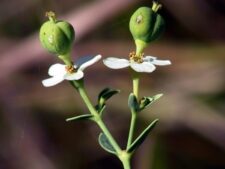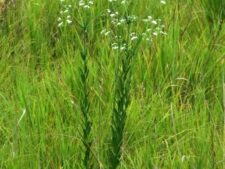
FLOWERING SPURGE
Euphorbia corollata
SPURGE FAMILY (Euphorbiaceae)
 Identification
Identification
- Flowering time - June, July, August, September
- Locally common at Neale Woods (see occurrence section for details)
- Single stem with several branching flower stalks at the top
- Whorl of leaves at the base of the main flower stalks
- Unique 3-lobed fruit
This native perennial has an unbranched stem usually 2-3 feet tall (D). Milky sap is present in the stem and and smooth narrowly elliptical leaves. The leaves are alternate except at the base of the flower stalks which rise above a whorl of leaves, one for each stalk (A). Flower stalks have many branches, forming a loose, often flat-topped flower cluster (cyme) (A). At the end of the final branch is a cup-like structure with 5 white, petal-like bracts (C) which are actually modified leaves analogous to the red “leaves” of our Christmas poinsettia. Inside the “petals” is a ring of yellowish male flowers and a single female flower which produces a rounded, three-lobed fruit on a short stalk projecting above the “petals” (B).
This prairie plant blooms from June through September in drier uplands. It is also often found in roadside ditches. It is common in the two small prairie transplants at Neale Woods and there a few plants in Knull Prairie. The first transplant is located just above the parking lot. The second is at the junction of Neale and Jonas Trails.
Flowering Spurge has showier “flowers” and is taller and more robust than our other Euphorbias. Milky sap, the characteristic whorl of leaves below the branching flower stalks and its unique fruit separate this plant from the white flowered Fleabanes and Asters.
The milky juice is toxic and a skin irritant.
The content of NatureSearch is provided by dedicated volunteer Naturalists of Fontenelle Forest who strive to provide the most accurate information available. Contributors of the images retain their copyrights. The point of contact for this page is: Neal Ratzlaff.



